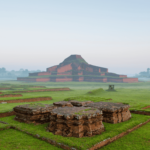Introduction:
Bangladeshi food is a world of vibrant spices, rich aromas, and unique flavors that tell the story of its culture and history! In this guide, we’ll uncover everything from the everyday dishes that fuel Bangladeshi families to the street food that fills bustling city markets. Bangladesh has a unique culinary heritage influenced by ancient traditions, diverse geography, and age-old cooking techniques. Whether you’re a food enthusiast or planning a visit, you’ll discover the essential dishes and flavors that define Bangladeshi cuisine. Let’s dig into the foods that make Bangladesh a hidden gem for food lovers around the globe!
An Overview of Bangladeshi Cuisine
Bangladeshi cuisine is a colorful mosaic of flavors, with dishes that reflect the country’s diverse landscape and rich heritage. From the lush plains and river deltas to the coastal regions, each area brings its unique ingredients and cooking techniques to the table. One of the most striking aspects of Bangladeshi food is its reliance on fresh, locally-sourced ingredients—especially rice, fish, and lentils. Fish, especially Ilish or Hilsa, is highly regarded, symbolizing not only nourishment but cultural pride.
Spices like turmeric, cumin, and coriander are staples in nearly every dish, contributing to vibrant flavors and aromatic profiles. What makes Bangladeshi food special is its balance: it’s rich but not overly spicy, flavorful yet comforting. Food is central to Bangladeshi culture and plays a vital role in social gatherings, festivals, and family celebrations.
Staple Foods in Bangladesh
Staple foods in Bangladesh revolve around rice, fish, and dal (lentils). Rice, often eaten at every meal, comes in several varieties—each suited for different dishes. Whether steamed, fried, or cooked with lentils, rice is a foundation upon which other flavors build.
Fish is a key part of Bangladeshi cuisine, particularly freshwater varieties like Rui (rohu) and Katla, along with the much-loved Ilish (Hilsa). Ilish is especially treasured, often cooked with mustard or steamed with aromatic spices. Dal is another staple, usually cooked simply but seasoned with ghee, green chilies, and onions to elevate the dish. These staples form the base of countless meals, offering nutrition and flavor that suit everyday Bangladeshi dining.
Popular Bangladeshi Dishes You Must Try
- Bhuna Khichuri: Known as the ultimate comfort food, Bhuna Khichuri is a one-pot meal made with rice and lentils, often served with fried fish, egg, or meat.
- Biryani: A highlight of Bangladeshi cuisine, this flavorful rice dish has regional varieties, with Dhaka Biryani being among the most famous. Fragrant with saffron, ghee, and spices, it’s often served during celebrations and holidays.
- Shorshe Ilish: This dish of Hilsa fish cooked in mustard paste is a culinary treasure. The sharpness of mustard complements the fish’s richness, creating an iconic Bengali flavor.
- Fuchka and Chotpoti: Beloved street foods, Fuchka and Chotpoti are spicy, tangy, and crispy treats that bring together chickpeas, potatoes, and tamarind chutney.
Vegetarian Delights in Bangladeshi Cuisine
Vegetarian foods are popular in Bangladesh, and dishes often feature seasonal vegetables and leafy greens. Shak Bhaji (sautéed leafy greens) is a common side dish, prepared with mustard oil, garlic, and green chili. Alu Bhorta (mashed potatoes) brings a comforting taste with a kick, thanks to green chili, onions, and mustard oil. Begun Bhaji, a fried eggplant dish, is another favorite, especially as a side to rice. These vegetarian offerings are simple yet full of flavor, perfect for any meal.
Street Food and Snacks in Bangladesh
Street food is essential to Bangladeshi culinary culture, especially in urban areas. You’ll find vendors selling Singara and Samosa, crispy pastries filled with spiced potatoes, or sometimes meat, often served with chutneys. Muri (Puffed Rice) is another light snack mixed with spices, oil, and chili—a favorite for quick bites. Jhalmuri, a spicy puffed rice mixture, is an iconic street food packed with flavor and crunch. In cities like Dhaka and Chittagong, these snacks are not just food but a part of daily life, bringing people together in bustling markets and street corners.
Traditional Sweets and Desserts
Bangladeshi sweets are famous for their unique textures and flavors. Rasgulla and Sandesh are made from fresh chhena (cottage cheese) and sugar, often flavored with cardamom or rosewater. Misti Doi (Sweet Yogurt) is another beloved dessert, with its thick, caramelized texture and mildly sweet taste. During winter, locals enjoy Pitha, rice cakes made in various shapes and flavors. These traditional sweets are a source of pride, enjoyed during festivals and family celebrations, adding a sweet ending to every meal.
Eating Customs and Dining Etiquette in Bangladesh
Dining in Bangladesh is typically a communal affair, with family and friends sharing dishes at the table. Meals often begin with lighter dishes and move on to heavier curries, with rice being central to every course. Sharing is a big part of the dining experience, and it’s common for everyone to eat from shared plates, especially in rural areas. Hospitality is crucial, and guests are always offered the best parts of each dish as a sign of respect and welcome.
Bangladeshi Foods You Can Try at Home
Cooking Bangladeshi food at home can be surprisingly simple with the right ingredients. Start with essentials like turmeric, mustard oil, cumin, and green chilies. Dal (lentil soup), Bhuna Khichuri, and Alu Bhorta are great introductory dishes. These recipes don’t require advanced skills but are packed with flavor, perfect for those new to Bangladeshi cuisine. Experimenting with these dishes allows you to appreciate the depth of flavors that characterize Bangladeshi food, giving you a taste of its culture right from your own kitchen.
Conclusion:
Exploring Bangladeshi foods is like taking a journey through the country’s heart and soul—its history, culture, and the warm spirit of its people. From everyday staples like rice and fish to the intricate sweets and street foods, Bangladeshi cuisine is both comforting and exciting, with flavors that captivate anyone willing to try. If you’re ready to dive deeper, try recreating some of these dishes at home, or better yet, visit Bangladesh to experience its culinary traditions firsthand. Don’t forget to share your culinary experiences—Bangladeshi food is meant to be celebrated with others!







